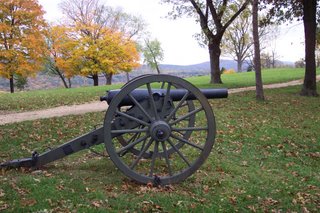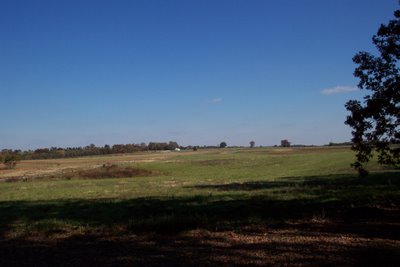This was easy as there are many National Park Service Civil War battlefields around this area, a fact which caused Aaron to ask me why the Civil War armies chose to fight so many of their battles in National Parks.

On Monday, we went to Bolivar Heights, the hill above Harpers Ferry where Confederate General Stonewall Jackson captured 12,419 Union troops in 1862--the largest surrender of American fighting men that ever occurred until Corregidor fell during WW2.
Shown here is one of the cannon at Bolivar Heights. This is a Union gun--a 3" ordinance rifle that fired a ten pound cannonball. Cute little sucker, ain't it? Makes me wish I'd put that trailer hitch on my jeep. The Confederates captured 73 of these here along with their prisoners.
On Tuesday we went to Antietam. The battle here occurred just a few days after the stunning Confederate victory at Bolivar Heights. 23,000 men died in one day, making it the bloodiest day in American history. The Union victory here ended the Confederate invasion of the North.
 This is the Lower Bridge over Antietam Creek, now known as "Burnside's Bridge" after Union General Burnside threw division after division of troops at it in a pathetically bungled attempt to capture it. The problem was that a line of about 450 Confederate riflemen were dug in on the hill just above it, and they shot down the Union soldiers as soon as they reached the bridge. The Federals finally took it but lost hundreds of men. Ironically they could have waded the creek anywhere and outflanked the Confederates easily if they hadn't been so fixated on taking the bridge itself by frontal assault.
This is the Lower Bridge over Antietam Creek, now known as "Burnside's Bridge" after Union General Burnside threw division after division of troops at it in a pathetically bungled attempt to capture it. The problem was that a line of about 450 Confederate riflemen were dug in on the hill just above it, and they shot down the Union soldiers as soon as they reached the bridge. The Federals finally took it but lost hundreds of men. Ironically they could have waded the creek anywhere and outflanked the Confederates easily if they hadn't been so fixated on taking the bridge itself by frontal assault.But on this day, there was one Federal on the bridge with a gun. That was me with my Glock. And I was getting sore from a long crutch-walk to and across it. But it was good.
On Thursday, Aaron and I went to Gettysburg National Military Park. Here we checked out the Visitor Center for a bit and then we took the 18 mile driving tour around the Battlefield. They offer two mapped tours--a two hour one and a three hour one. We wanted to see it all but I told Aaron that I was reluctant to go on the latter one.

Three hour tours are unlucky. Remember Gilligan? That all started with a "three hour tour" too. I never go on three hour tours now. I don't want to get stuck on an island.
So we drove, and looked at the various markers and critiqued the battle while we went along. And yes, I think that we could have done better then the Generals of the day did back in July of 1863. Let me state right now that I've always admired and respected Confederate General Robert E. Lee, but had I been running the show that day instead of him, there would have been no disasterous "Pickett's Charge". I don't know what Lee was thinking on July 3rd, but he sent a numerically-inferior force of over 12,000 soldiers on a 3/4 mile long march in broad daylight across open fields against a dug-in Union line with 300 cannon and more riflemen than Lee was sending.

This picture above was taken from the spot where Lee's troops began their assault and it shows the objective. Those three small stands of trees way out in front and that little white barn left of center represent the center of the Union line. Imagine making that walk under the hot July sun with hundreds of cannon and thousands of riflemen all dug in over there shooting at you the whole way.
No suprise, the attacking Confederate forces were slaughtered and lost over half of their number, better than 6,500 men. This included many of the CSA's officer Corps, and the Army of the Confederacy never recovered from this debacle.
We hit Little Round Top next. This was an important hill which was for all intents and purposes the end of the main Union line. However for some stupid reason it was also practically devoid of Union troops on July 2nd when the Confederates launched an attack on it. Had they captured this hill, the Union forces would have been outflanked and nearly surrounded. But Brigadier General Gouverneur K. Warren, an engineer with the Union Signal Corps, suddenly realized this and frantically worked to get Union soldiers onto the hill as the Confederates came on. The Union troops took to the hilltop just in time, throwing up crude stone wall breastworks and firing back down onto the attackers. The Confederates then dug in below the hill and their sharpshooters began picking off exposed Union troops. Finally the Union managed to push the Confederates off with a bayonet charge down the hill. Both sides skirmished back and forth around this hill for the rest of that day and the next, until finally the Confederates pulled back, losing 1,185 men dead, wounded or missing. The Union lost 565 men. A Confederate victory here would have put the Union line in serious jeopardy and made Pickett's Charge unnecessary the next day.
 Here's Aaron telling everyone how he would have fought this battle. On the left can be seen some of the rocks piled up by Union soldiers as a hasty defense against Southern rifle balls.
Here's Aaron telling everyone how he would have fought this battle. On the left can be seen some of the rocks piled up by Union soldiers as a hasty defense against Southern rifle balls.Gettysburg was the beginning of the end for the Confederacy. It was also a bloody tragedy where 51,000 men were killed or wounded in just three days. A defeated Lee pulled his shattered force back towards Virginia, and had Union General Meade followed up with an attack he might have taken Lee and his entire army and brought the war to a virtual close. But Meade wasn't known for his agressiveness and he let Lee slip away, a fact which caused President Lincoln to eventually remove him from command. And soon both armies were gone, leaving the local townsfolk the task of burying the thousands of dead from both sides. I heard that it took them over five years to find and bury them all. And reading about it is one thing, but it's no substitute for actually seeing the sites and walking the land.
Finally we headed back. We stopped at Harpers Ferry on the way back for ice cream at Swiss Miss (Lagniappe's favorite) and I showed Aaron some of the local sights, including the old firehouse where John Brown and his band of terrorists were holed up after their attack on the United States Arsenal here went bad.

They were eventually captured by an obscure United States Colonel named Robert E. Lee and an equally obscure United States Lieutenant named JEB Stuart. These men went on to greatness when they switched sides a few years later and fought as heroes of the Confederacy. That's right--General Lee of Gettysburg fame was once here at the beginning as a Union Colonel.
I am sorry that we didn't get down to Manassas for a day, but the next time he comes, we'll hit that and Fredericksburg. As it was, we had a good time, got a lot of work done, saw a lot of historic sites, and dranks a fair amount of beer. It's good to have a "guy week" sometimes.

"Is he gone yet?" Lagniappe was a bit jealous of and put out by my company. But he's happy now that Aaron's gone. Silly insecure dog.
Cute dog,and I liked the first two pictures too
ReplyDeleteThanks Michelle. Unfortunately he knows he's cute and he exploits it shamelessly.
ReplyDeleteSince you brought it up, the age-old question arises: Ginger or MaryAnn?
ReplyDeleteAnd why would you complain about being marooned with either of them?